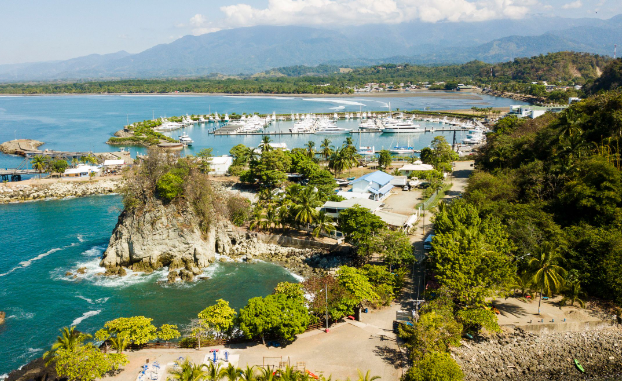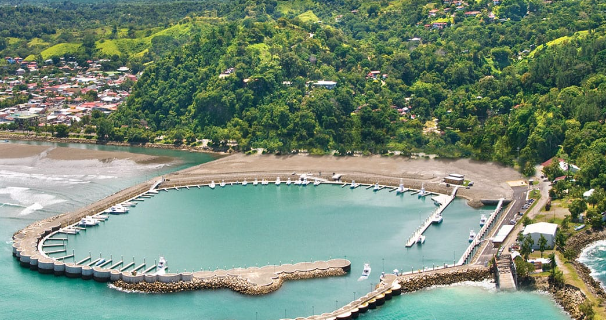When you hear the name Costa Rica, it conjures images of a beautiful country. In Spanish, Costa Rica means “rich coast,” and “rica” can also mean “delicious” when talking about food. TV shows and Hollywood movies often depict it as a stunning natural paradise—after all, even Jurassic Park was filmed there. Friends who have visited described it as beautiful and affordable, and the country’s slogan, “pura vida,” meaning “pure life,” sounds amazing. So, it’s no surprise that I had high expectations when visiting!

In January 2023, Yasmin and I entered Costa Rica by public bus. The scenery was lush and green, but it reminded me a lot of Java, just without the roadside stalls. As we neared Quepos, we were suddenly dropped off on the side of the highway, even though we were supposed to be dropped off at the bus terminal! The bus driver unloaded our luggage and directed us to a taxi that was conveniently parked there. The taxi driver, who was clearly in cahoots with the bus driver, offered to take us for 25 USD. What? I quickly checked Google Maps—the city center was only about 6 km away. He was definitely trying to rip us off! I saw that the price on Uber was half that, so I booked a ride. But after a long wait, the Uber driver just leisurely drove around and then canceled the trip.
There we were, standing on a deserted road in the scorching midday heat with no other transportation in sight. Passersby told us we’d have to wait for a taxi. It’s worth noting that taxis here can be any car, and prices are all about haggling. Finally, an older man in a beat-up sedan stopped. After agreeing on a price, he drove us to our Airbnb. When it came time to pay, he asked for extra, claiming, “The road is narrow and winding!” What? My first impression of Costa Rica was immediately soured.
We had just sat down at our Airbnb when the host demanded payment (the website didn’t allow credit card payments). Since we didn’t have Costa Rican colónes yet, we had no choice but to accept the unfavorable USD exchange rate he offered. Later, when we went out to eat, I was shocked at the prices! A simple meal at a regular restaurant cost at least 12.5 USD per person. Groceries were also expensive, even more so than in Panama, which has a higher GDP.
We had come to Quepos to visit Manuel Antonio National Park, which was supposed to have beautiful forests, beaches, and capuchin monkeys. I bought tickets online from the official website, but the site froze. Armed with a screenshot, we headed to the park the next day, only to be told, “No ticket, no entry!” The staff directed us to a scalper standing right next to the ticket counter, selling tickets for double the price! I couldn’t believe it—corruption in broad daylight!
Scalpers were everywhere outside, selling tickets at outrageous prices. It seemed like a common practice. Frustrated, we decided not to visit the national park. To calm down, we stopped at a small cafe tucked away at the end of the road. We ordered iced coffee with milk, which was listed on the menu for 2,500 CRC (around $4 USD). But when the bill came, it was 3,000 CRC + tax + service charge! Naturally, I protested! The waiter, chuckling, said, “2,500 is for regular coffee. Yours is special!” What a scam!
Our experience in the capital, San Jose, wasn’t any better. Although our hotel was located in the city center near shopping areas, the atmosphere was unsettling. All the stores closed by 7 p.m., and the streets became eerily dark and empty. This was a clear sign that the area wasn’t safe. Sure enough, the streets were filled with homeless people and drug users. We were too scared to go out at night.
One hallmark of a poorly run country is when Google Maps doesn’t show public transportation options. Buses were plentiful, but the routes were unclear. One night, we went out with some Indonesian friends studying there; even they struggled to figure out how to catch a bus to Escazu! First, we had to ask passersby where the bus stop was, then walked in the dark through the city center. Then, we had to ask each parked bus driver if their route passed by our destination. Once we got on, the bus was old and the driver was speeding! In the end, we could only visit places in San Jose that were within walking distance or, if too far, resorted to Uber.
Maybe the capital just wasn’t for us, so we considered moving to La Fortuna or Monteverde. But again, finding a public bus was nearly impossible due to the lack of information! Every website recommended taking a shuttle bus for $65 USD per person! And once we got there, we’d have to pay around $80 USD per person for tours since there was no public transportation. Even the entrance fee to a waterfall was $18 USD! No way! The places we saw in pictures—mountains, lakes, forests, waterfalls—looked just like Indonesia, and for those prices, it just didn’t seem worth it!
After much discussion, we decided to leave Costa Rica. Again, due to the lack of information, we had to visit three different bus terminals just to find tickets to Peñas Blancas! It turned out that buses depend on the company, so terminals aren’t centralized but scattered across the city. It was like trying to catch a bus at Blok M, then heading to Rambutan, only to find out the bus was actually at Ciledug! Exhausting! Costa Rica wasn’t as developed as I had expected.
Anyway, these are just some of my personal experiences that left me unimpressed with Costa Rica. Or maybe my expectations were just too high. Perhaps this is what happens with gentrification. As more Americans move to Costa Rica, the cost of living has skyrocketed, and the locals have been pushed to the fringes. Sadly, the original culture is fading, the language is shifting from Spanish to English, and even the currency is increasingly replaced by the U.S. dollar instead of the colón.

This Central American journey was self-funded, without any sponsorship. If you enjoy reading my travel stories, feel free to contribute some “pocket money” here to keep me motivated to write more. Thank you!

Make certain any physician or dentist who treats you is conscious of that you are
utilizing this medication. This medicine may cause modifications in mood or behavior for some sufferers.
Inform your doctor instantly in case you have depression, temper swings, a false or unusual sense of well-being, trouble with sleeping,
or character modifications whereas taking this medication. Verify
together with your physician instantly if blurred vision, difficulty in studying, eye ache, or some other change
in imaginative and prescient occurs during or after remedy.
With 4 years of relevant experience, she is passionate about conveying accurate and up-to-date info by way of her writing.
Her area of expertise consists of writing on habit
challenges, providing guidance on therapy procedures, and addressing co-occurring psychological issues.
It is generally advisable to remain away from alcohol on steroid remedy.
Although topical and injectable steroids haven’t been proven to elicit a reaction. After ending your prescribed course
of steroids, you need to contemplate waiting
at least a week earlier than consuming your first drink.
We know that it just isn’t uncommon to battle together with your mental health when you may have cancer or care for someone with cancer.
Avoid shut contact with people who’ve lately had reside vaccines taken by mouth (oral vaccines) such
as oral polio or the typhoid vaccine. If you might have epilepsy this might turn into worse when taking
steroids. You might need a burning or tingling sensation around your bottom during a steroid injection into a vein (intravenous).
However, this examine could suggest that briefly taking steroids may assist somebody maximize their pure potential with
more everlasting outcomes. Another benefit of injectable Dianabol is that when taken orally,
the liver will break down a number of the compound, making
it much less bioavailable. Thus, though a major
quantity of the steroid might be active as a outcome of C17-alpha alkylation, if you’re taking 30 mg of Dianabol, the true dose could only be 26 mg.
In contrast, users who inject 30 mg of Dianabol will expertise the total dose.
We start these medications as quickly as Dianabol has absolutely left the physique.
Cancer medication can u drink on steroids
work together with medicines, herbal merchandise, and some
food and drinks. We are unable to record all of the attainable interactions that will happen. An instance is grapefruit or grapefruit juice
which may enhance the side effects of certain drugs.
Prednisolone may cause unwanted effects that vary from delicate to serious.
If prednisolone unwanted facet effects turn out to be difficult to tolerate, speak with
your physician about coping suggestions or
other therapy options. Each prednisone and prednisolone are man-made glucocorticoids.
They are used to deal with comparable circumstances and are usually thought-about equally effective.
For maximum outcomes, customers ought to decrease alcohol consumption throughout a cycle.
Nevertheless, low quantities of alcohol are unlikely to have an effect on a user’s outcomes
considerably. Prednisone belongs to a group of medicines known as corticosteroids.
It has anti-inflammatory results and may regulate the body’s metabolism
and immune response. In terms of weight gain, it’s common for customers to gain 20 pounds in the first
30 days on Dianabol (3). Most of this shall be in the
form of muscle mass (plus some water retention).
Corticosteroids differ of their relative quantity of anti-inflammatory
and mineralocorticoid efficiency and they are used according
to these results. Corticosteroids, since they
suppress the immune system, can result in a rise within the price of infections
and cut back the effectiveness of vaccines and antibiotics.
Corticosteroids have many unwanted aspect effects that
can be gentle or severe. These unwanted effects are extra apparent when corticosteroids are used at larger doses or for extended
durations of time.
Ideally, the affected person can take completely different drugs
long-term to help prevent future flares. If needed long-term, the lowest effective
dose ought to be used. ChoicePoint goals to enhance
the standard of life for people struggling with substance use dysfunction and mental health issues.
70918248
References:
what do all steroids have in common (https://www.quimka.net/a344320-מתי-הם-ילמדו-ג-ביל-ו-הרצל-וכל-השאר)
70918248
References:
Why Do Anabolic Steroids Differ From Other Illegal Drugs?
– https://Sldiginetconsultancy.Com –
Your article helped me a lot, is there any more related content? Thanks!